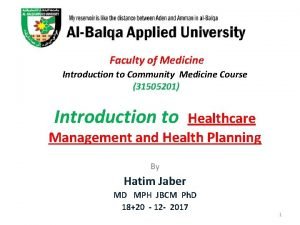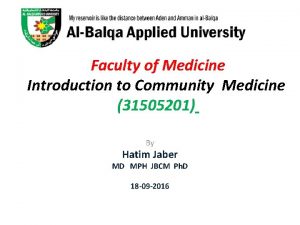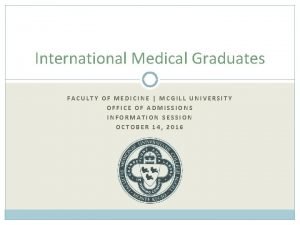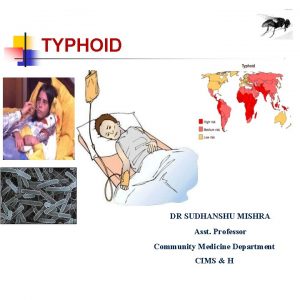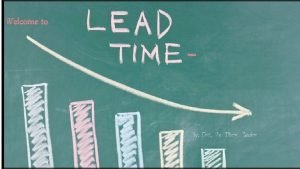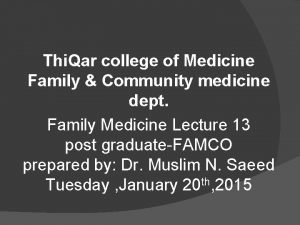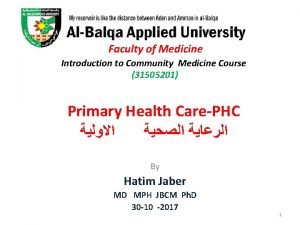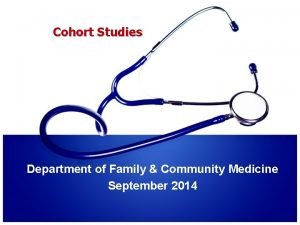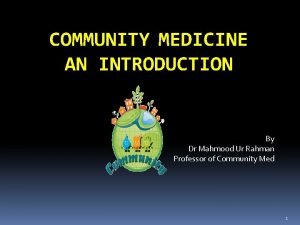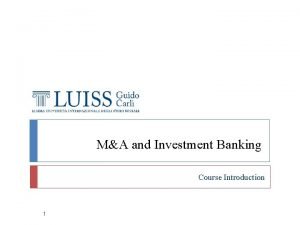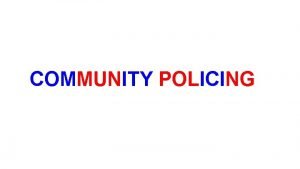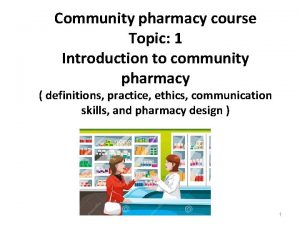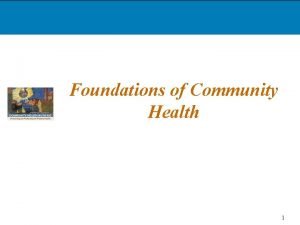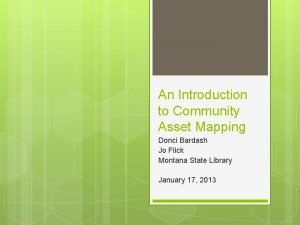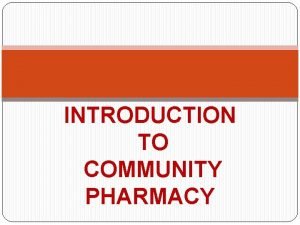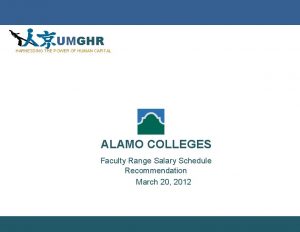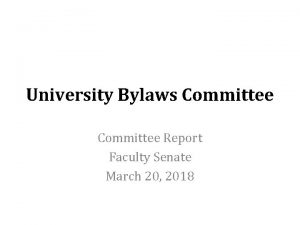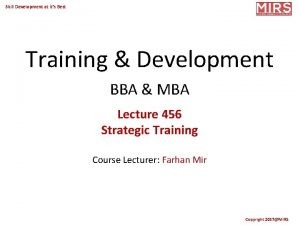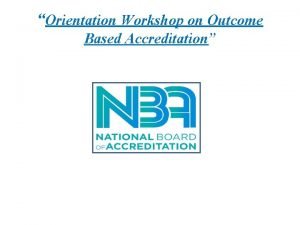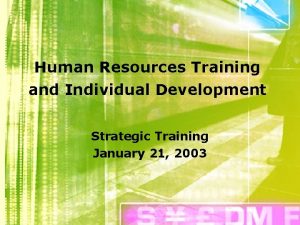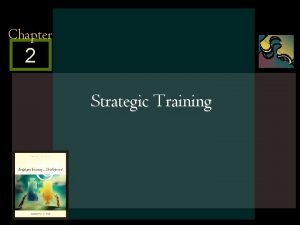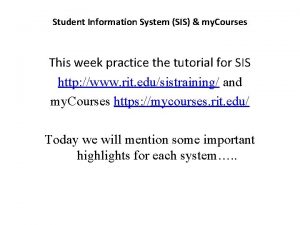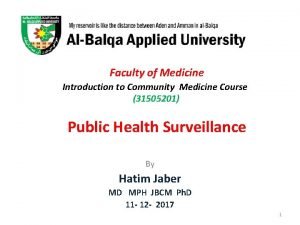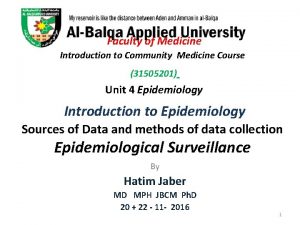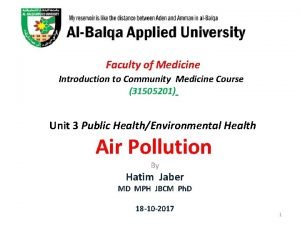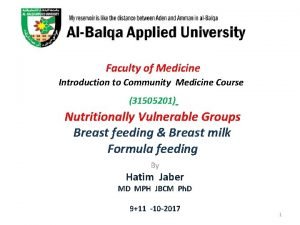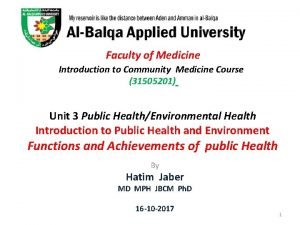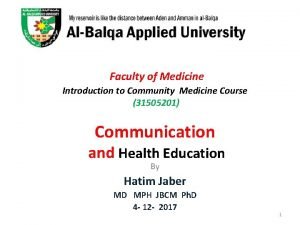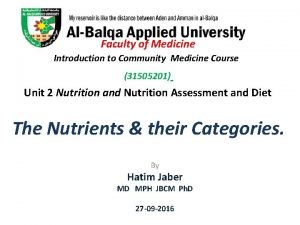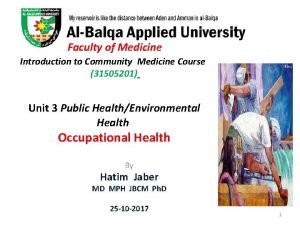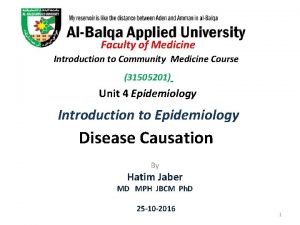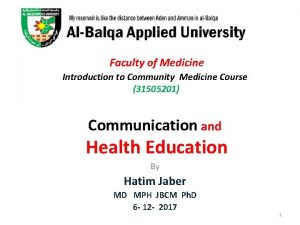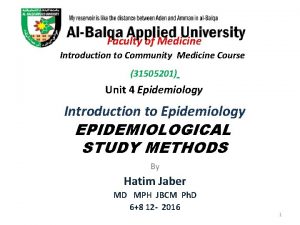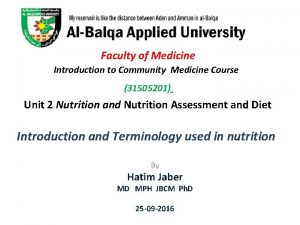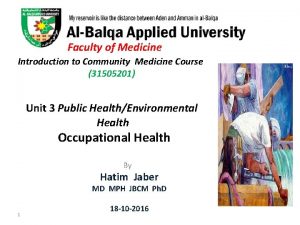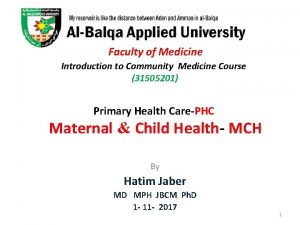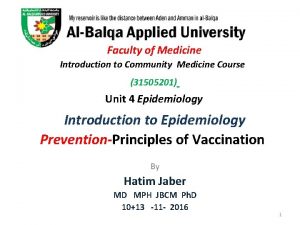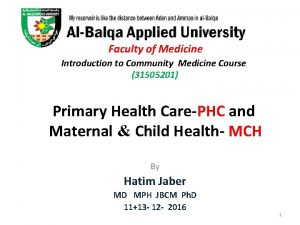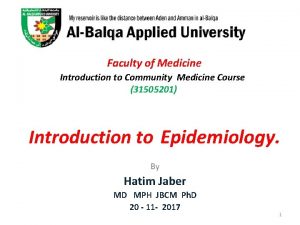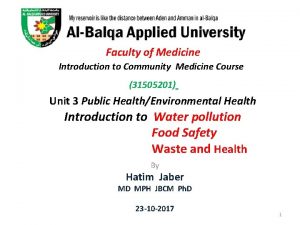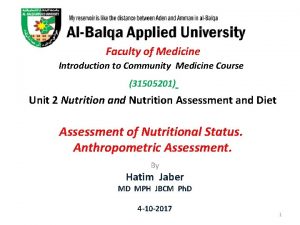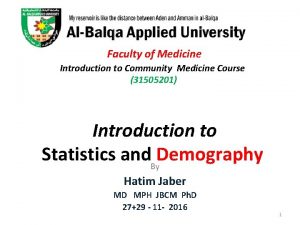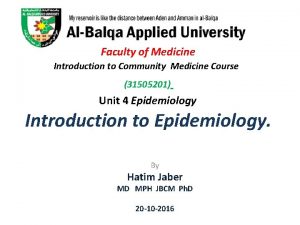Faculty of Medicine Introduction to Community Medicine Course




































































































- Slides: 100

Faculty of Medicine Introduction to Community Medicine Course (31505201) Introduction to Healthcare Management and Health Planning By Hatim Jaber MD MPH JBCM Ph. D 20+22 - 12 --2016 1

2

Presentation outline Time Introduction and Definitions 12: 00 to 12: 10 Health Care System and its components 12: 10 to 12: 20 Levels of Health care, and the main 12: 20 to 12: 50 approaches to health care provision, in addition to Resources, and Financing Introduction to Management in health care Next Lecture organizations The Four Functions of Management: Planning, Next Lecture Organizing, Leading and Controlling. The planning cycle and Health Systems Planning Health Policy Next Lecture 3

• Health Policy • International health policy • Health policy reform • Health systems • Quality of healthcare • Health management and administration • Management functions • Management principles • Planning Cycle • Types and levels of planning • Team work • Supervision and monitoring • Evaluation 4

Health Policy Defined • Health policies are public policies or authoritative decisions that pertain to health or influence the pursuit of health • Health policies affect or influence groups or classes of individuals or organizations 5

Public vs. Private Policymaking • Public Policy – Policy that is established by the federal, state, and local levels of government • Private Policy – Policy that is established by private organizations • Public Policies – are authoritative decisions made in the legislative, executive, or judicial branches of government • intended to direct or influence the actions, behaviors, or decisions of others • Health Policy – the aggregate principles, stated or unstated • that characterize the distribution of resources, services, and political influences – that impact on the health of the population 6

The Policy Cycle The formation and implementation of health policy occurs in a policy cycle comprising five components: 1. ) issue raising 2. ) policy design 3. ) public support building 4. ) legislative decision making and policy support building 5) legislative decision making and policy implementation 7

The policy cycle Sound health financing policy planning, implementation, management, and analysis requires a good knowledge of health financing issues, contextual constraints and opportunities. • It also requires adequate tools to support a systematic approach to the issues. • • • 8

The Policy Cycle Stages 9

10

Forms of Health Policies • There are five main forms of health policies – Laws – Rules/Regulations – Operational Decisions – Judicial Decisions – Macro Policies 11

Categories of Public Health Policies • Public health policies are grouped into two categories – Allocative – Regulatory 12

Historical Development of Term • Public Health: Developed as a discipline in the mid 19 th century in UK, Europe and US. Concerned more with national issues. – Data and evidence to support action, focus on populations, social justice and equity, emphasis on preventions vs cure. • International Health: Developed during past decades, came to be more concerned with – the diseases (e. g. tropical diseases) and – conditions (war, natural disasters) of middle and low income countries. – Tended to denote a one way flow of ‘good ideas’. • Global Health: More recent in its origin and emphasises a greater scope of health problems and solutions – that transcend national boundaries – requiring greater inter-disciplinary approach 13

From individual to Global Health International Health Public Health • Health problems know no boundary • Health in the interconnected context, globalization, extends beyond problem on and capability of one country • Problem and/or concern beyond frontier • Focuses on solving health problem in developing countries • Health problem within national boundary • aims to promote health of the population through prevention and health promotion including sanitation Individual Health << Family Health << Community Health Source: J P Koplan et al. Towards a common definition of global health Lancet 4 14

Quality Carrying out interventions correctly according to pre-established standards and procedures, with an aim of satisfying the customers of the health system and maximizing results without generating health risks or unnecessary costs. 15

Dimensions of Quality • • Technical competence Access to service Effectiveness Efficiency Amenities Interpersonal relations Continuity Safety 16

What Is Health Care Quality? • “The degree to which health services for individuals and populations increase the likelihood of desired health outcomes and are consistent with current professional knowledge. ” • -- Institute of Medicine 17

Key Components of High Quality Health Care – Safe – Effective – Patient-centered – Timely – Efficient – Equitable -- Institute of Medicine, 2001 18

Quality Controls • These regulations are intended to ensure that health services providers adhere to acceptable levels of quality in the services they provide and that producers of healthrelated products meet safety and efficacy standards 19

Quality Control • Quality control in health care organization refers to activities that evaluate, monitor or regulate services rendered to consumers. Observe Identify Track • The process • Variable characteristics • Variables through statistical methods 20

What is a Health Care System? What is a System? • System: “a set or arrangement of things connected or related to form a unity or organic whole”. • System: “a collection of components organized to accomplish a specific function or a set of functions”. ü The parts of a system can be referred to as its elements or components ü The environment of the system is defined as all of the factors that affect the system and are affected by it. 21

What is a Health Care System? • A Health Care System: “the complete network of agencies, facilities, and all providers of health care in a specified geographic area. ” (Mosby's Medical Dictionary, 8 th edition. © 2009, Elsevier. ) : “an organized plan of health services. ” Every country has a health care system, however fragmented it may be among different organizations or however 22

Health Care Systems • Health care systems are designed to meet the health care needs of target populations. In some countries, the health care system has evolved and has not been planned, whereas in others efforts have been made by: --- governments, • trade unions, charities, religious, • or other coordinated bodies to deliver planned health care services targeted to the populations they serve. 23

Goals of a Health Care System The goals for health systems, according to the World Health Report (WHO, 2000), are: • Good health for the population • Responsiveness to the needs and expectations of the population • Fair financial contribution to the health care system • Efficient to achieve the best outcomes possible given available resources and circumstances 24

What is a Health Care Delivery System? Three major components that make up the Health Care Delivery System are: 1. Facilities 2. Practitioners 3. Entities 25

Facilities • Hospitals: acute and sub-acute care, primary care, and tertiary care (medical education and complex cases) • Health Centers or Ambulatory Surgery (out-patient) • Physician offices (GP, s and specialists) • Skilled Nursing Facilities • Home Health Agencies: nursing care at home • Freestanding Substance Abuse Facilities: inpatient • Hospice: care for terminally ill patients • End-stage Renal Disease Centers 26

Practitioners Physicians • Medical Doctors (MD’s) Nurses • Nurse Practitioners • Registered Nurse (RN) Physician Assistants (Pas) Therapists • Physiotherapist (PT) • Occupational therapist (OT) • Speech therapist (ST) 27

Entities Provide the financial and regulatory functions for the facilities and practitioners, e. g. government. Governmental Health Care Functions: 1. 2. 3. 4. Direct Services (hospitals, health care centers) Financing Information Policy Setting 28

Health Care Delivery System 29

30

Elements of a health care system One way to look at the HCS is by identifying elements of a health care system that embrace the following: (1) Personal health care services for individuals and families, available at hospitals, clinics, neighborhood centers, and in physicians' offices, etc……. (2) Public health services needed to maintain a healthy environment, such as control of water and food supplies, regulation of drugs, and safety regulations. (3) Teaching and research activities related to the prevention, detection, and treatment of disease. (4) Third party (health insurance, pharmaceutical companies) of system services. 31

Key components of a well functioning health system Health System Building Blocks • The building blocks alone do not constitute a system, any more than a pile of bricks constitutes a functioning building. • It is the multiple relationships and interactions (integration) among the blocks – how one affects and influences the others, and is in turn affected by them – that convert these blocks into a system. 32

Health system In Jordan Health system governance in Jordan has been characterized by a stable political system which seeks to identify and allocate responsibilities between the public and private sectors. The government is responsible for supervising, monitoring and enacting laws for the protection of public rights and justice between the citizens. 33

The health sector in Jordan consists of: Service providers (public, private, international and charity sectors) and councils and institutions working on the development of health policy. The public sector includes the: Ministry of Health, the Royal Medical Services and university hospitals (University of Jordan Hospital, King Abdullah University hospital) and the centre for diabetes and Endocrinology and Genetics. The private sector includes private hospitals and diagnostic and therapeutic centers in addition to hundreds of private clinics. 34

The international sector and charitable sectors provide services through: UNRWA clinics for Palestinian refugees and the UNHCR and King Hussein Cancer Center and charity association clinics. Drawing the general policy for health sector in Jordan is done mainly through: the Higher Health Council pursuant to law No. 9 of 1999. It is noted that there are other institutions in the health sector involved in health policy, such as the Jordanian Medical Council, the Supreme Council of the population, the Jordanian Nursing Council, the National Council for Family Affairs, Jordan Food and Drug Administration and the Joint procurement Department 35

Major components of health sector in Jordan 36

37

38

39

40

41

42

Presentation outline Time Introduction and Definitions 12: 00 to 12: 10 Health Care System and its components 12: 10 to 12: 20 Levels of Health care, and the main approaches to health care provision, in addition to Resources, and Financing 12: 20 to 12: 50 Time 12: 00 to 12: 10 Introduction to Management in health care organizations The Four Functions of Management: Planning, 12: 10 to 12: 20 Organizing, Leading and Controlling. The planning cycle and Health Systems Planning Health Policy 12: 20 to 12: 50 43

• Health Policy • International health policy • Health policy reform • Health systems • Quality of healthcare • Health management and administration • Management functions • Management principles • Planning Cycle • Types and levels of planning • Team work • Supervision and monitoring • Evaluation 44

Management • Management is the operational part of administration. • It is defined as: “ It is a set of interactive processes through which the utilization of resources results in the accomplishment of organization objectives. ” It is through “management” that the objectives of the health care organization are achieved by gathering and positioning of resources. • It is a “conversion mechanism”. 45

Definitions and concepts MANAGEMENT is both a SCIENCE and ART • As a SCIENCE, management has basic rules and principles. • As an ART, successful managers learn through experience, they follow flexible, adaptive, innovative approaches to fulfill objectives. 46

Definitions Management is getting things effectively done to achieve desired objectives through proper planning, efficient implementation and evaluation to identify the needs for re-planning. Management is thus a dynamic process. 47

• Effectiveness is the degree to which a stated objective is being achieved. • Efficiency is the optimized (balanced) use of resources (Human resources, equipment, supplies, money, space, time & information). 48

Definitions Management is a decision making process translating the policies into plans, implementing those plans, and evaluate the plans and the interventions to re-plan to achieve better results 49

Good Management • Highlights priorities • Adapts services to needs and to changing situations (dynamic) • Makes most of limited resources • Improves the standard and quality of services • Maintains high staff morale 50

PRINCIPLES OF MANAGEMENT 1. Management by objectives: Setting targets (goals and objectives) 2. Learning from experience 3. Teamwork 4. Proper use of resources 5. Putting priorities 51

Management Process I. Planning II. Implementation: – Organizing – Staffing – Leading/Directing – Controlling /Monitoring III. Evaluation 52

A systems view of management Process Inputs Human resources Non-human resources Conversion mechanism Outputs Objectives achievement 53

Management Skills Technical skills Human skills Technical skills Mainly firs level Human / interpersonal skills All levels Conceptual skills Mainly top level + Political skills 54

Health Administration Sound administration is essential for the success of any public health program whether on the national, intermediate or the local level. 55

Definition of Administration • We can define sound administration as: “ The process of achieving defined goals at a defined time through the guidance, leadership, and control of the efforts of a group of individuals and the efficient utilization of non-human resources bearing in mind adequacy, speed, and economy to the utmost possible level. ” 56

Another definition “Administration is the art and science of guidance, leadership, and control of the efforts of a group of individuals towards some common goal. ” 57

Administration • There are several elements for administration. In practice all these elements are interrelated to one another. • There also 3 levels of administration. 58

Elements of Administration: • • • Planning Organization Staffing Directing Coordinating • • Reporting Budgeting Supervising Evaluation 59

Levels of Administration Central level Intermediate level Local Level Ministry of health directorates of health e. g. health office, Hospital, health care unit 60

61

62

Every program must have an overall (general) goal which confirms with that of the nation’s policy, and various objectives to be achieved according to a definite plan. 63

Goals versus Objectives • A GOAL: is a long range specified state of accomplishment towards the activity it is directed. Goals are not constrained by time or existing resources. • Example: the goal of public health services is to attain optimum health for all the people this may be accomplished through many objectives like provision for safe water for all villages within so many years , 64

AN OBJECTIVE: is a measurable state of accomplishment aimed towards the goal. The objective should include a description of “what” outcome is desired, “when” it is expected, and “where” it will take place. Example: objectives like raising the covering of vaccination to 100% after 2 years in a specific cit 65

Setting Objectives Should be SMART • Specific • Measurable • Attainable /Achievable • Relevant • Time-specific 66

Planning and management *Planning is for tomorrow. *Management is for today. 67

Planning • Planning is considered the most important element of the administrative process. • The higher the level of administration, the more the involvement and time devoting to planning. • A good plan is the basis of any successful program. • Sufficient time should be given to the process of planning. • More than one plan should be available to choose from to meet the existing plan. 68

Definition of Planning • “Planning is a projected or predetermined course of action designed to achieve a specific goal or objective. ” • Planning determines What? When? Where? How? Why? And by whom? Things will be done. • • It involves “decision making for future events”. 69

Process of systemic planning 1. Establishing goals and objectives 2. Designing alternative courses of action 3. Analyzing and predicting the consequences 4. Selecting the best course of action 5. Implementing the selected plan and performing periodic evaluation to assure success of plan 70

Principles of planning • Being an intellectual activity it needs knowledge, experience, foresight, reasoning and the mastering of special skills and techniques. Examples of different techniques of planning are: – PPBS: Planning/Programming/Budgeting system – PERT: Performance/Evaluation/Review technique – CPM: Critical Path Method 71

• Planning is a dynamic (non-static) process • It is a continuous circular process Planning Evaluation • • Execution (implementation) Futuristic Decision making process Dynamic Flexible 72

How to stay here Where I want to be Objectives How Where I am now Situation analysis 73

• Participative planning is sharing the program planning with other people, staff and agencies concerned with the program. • Participative planning have advantages and disadvantages. 74

• Planning of a program is based on: – Needs and demands of the public – Available resources – Attitude of the public 75

• Constraints (intervening factors) to a plan may be social, economical or political, and they may be related to either: – External environment (community) – Internal environment (the organization) • Establishing priorities are essential in planning (What are these priorities? ? ? ) 76

The planning function includes 1. Situation analysis. 2. Problem identification and priority setting. 3. Objective setting. 4. Selection of alternative solutions/interventions. 5. Planning for resources. 6. Planning for monitoring and evaluation. 7. Planning for sustainability. 77

Organization • Definitions: “ Organization is any collection of persons, materials, procedures, ideas or facts arranged and ordered that the combination of parts makes a meaningful whole that works towards achieving organizational objectives. ” “The process of organization implies to the arrangement of human and non-human resources in an orderly fashion to make a meaningful whole that accomplishes organizational objectives. ” 78

Organization Human& Non human resources Arranged & ordered Meaningful whole Achieve objectives 79

Organization of health services It means any collection of persons , materials, procedures, ideas or facts so arranged & ordered that each case the combination of parts makes a meaningful whole that works at achieving organizational objectives 80

• The organizational process is classified into: – Structural organization – Functional organization 81

Principles of organization – Departmentation – Acquisition of human and non-human resources – Specialization and division of labor – Coordination –Authority and responsibility – Centralization and de-centralization – Unity of command – Line and staff 82

Staffing • It is the process of “personnelizing” the organization, by hiring the right type and adequate number of workers to each unit for the time required for the program, through the following steps: – – Identifying the type and number of personnel Recruitment Selection and appointment Orientation • Job analysis • Job description • Job specification 83

Financial administration • Financial administration consists of a series activities were funds are made available for certain people in the organization under procedures that will ensure their efficient use. • The main activities are: – Budgeting – Accounting – Auditing – Purchasing 84

Budgeting: It is the allocation of financial resources in support for programs or projects for a special period of time. A budget is defined as “a balanced estimate of expenditures and receipts for a given period of time”. 85

• Accounting: “It is recording assembly and summarization of financial effects of executive action. a harmonious relationship between budget and account is important to current comparisons, between goals set in and accomplished. ” 86

Auditing: “It is the investigation and report on the fidelity and legality of all financial transactions”. 87

Purchasing: “It is the acquisition of the property and materials needed in administration”. 88

Supervision • Supervision refers to the day-to-day relationship between an executive and his immediate subordinates. • Supervision aims at satisfying both: – Workers 89

Supervision • Motivation is defined as: “an externally induced behavior which occurs in order to bring about or maintain need fulfillment”. • The following conditions if present build high levels of motivation: • Achievement • Recognition • Advancement • Working conditions • Responsibility • Technical supervision • Interpersonal relations • Organizational policy • Salary and compensations • Job security 90

Supervision • Styles of leader authority: – Autocratic – Consultative – Participative – Democratic – Free rein 91

Supervision • Factors affecting style of supervision: – Condition present – Type of work – Subordinates characteristics – Personal characteristic of manager 92

Evaluation • Definition: “systemic collection of information about the activities, characteristics and outcomes of programs, personnel, and products for use by specific people to reduce uncertainties, improve effectiveness and make decision with regard to what those programs, personnel or products are doing and affecting. ” 93

Types of Evaluation Structure Process Outcome /impact 94

Types of Evaluation Facilities/ Equipment/ Manpower/ organization Measurable Indicators + Health related impacts Impact or summative Evaluation Program impact Structure evaluation Program planning Program Implementation Performance of staff/ way procedures are done Process or Formative evaluation 95

Elements of Evaluation • • Relevance Adequacy Accessibility Acceptability Effectiveness Efficiency Impact 96

Steps of Evaluation (1) Describe the program in terms of objectives expected. (2) specify the evaluation design. (3) gather credible evidence (information (4) Analysis and justification of results (5) Taking action 6) Re-evaluation Evaluation is an ongoing process. 97

Teamwork Whenever achievement of a common goal needs more than one individual to function together, then we need a teamwork. Together Each of us Achieves More 98

TEAMWORK There are four people named Everybody, Somebody, Anybody, and Nobody. There was an important job to be done. Everybody was asked to do it. Everybody was sure Somebody would do it, but Nobody did it. Somebody got angry about that, because it was Everybody's job. Everybody thought Anybody could do it but Nobody realized that Everybody wouldn't do it. It ended up that Everybody blamed Somebody when Nobody did what Anybody could have done. 99

Thank you 100
 Introduction to community medicine
Introduction to community medicine Introduction to community medicine
Introduction to community medicine Hubert kairuki memorial university faculty of medicine
Hubert kairuki memorial university faculty of medicine Semmelweis
Semmelweis Mrbs scholarship
Mrbs scholarship Applied medical sciences
Applied medical sciences Agnes csaki semmelweis
Agnes csaki semmelweis Faculty of veterinary medicine cairo university logo
Faculty of veterinary medicine cairo university logo Hacettepe university faculty of medicine
Hacettepe university faculty of medicine Faculty of veterinary medicine - university of tehran
Faculty of veterinary medicine - university of tehran Semmelweis university faculty of medicine
Semmelweis university faculty of medicine Mcgill medicine supporting documents
Mcgill medicine supporting documents Faculty of veterinary medicine cairo university
Faculty of veterinary medicine cairo university Pubh4401
Pubh4401 Emory anticoagulation clinic
Emory anticoagulation clinic Cairo university faculty of veterinary medicine
Cairo university faculty of veterinary medicine Faculty introduction speech
Faculty introduction speech Half brick wall vs one brick wall
Half brick wall vs one brick wall Course number and title
Course number and title Course interne moyenne externe
Course interne moyenne externe Drinking water
Drinking water Lead time in community medicine
Lead time in community medicine Types of family in community medicine
Types of family in community medicine Lead time in community medicine
Lead time in community medicine Kashif rahim
Kashif rahim Principles of primary health care
Principles of primary health care Cohort study community medicine
Cohort study community medicine Duke family medicine and community health
Duke family medicine and community health Seqs community medicine
Seqs community medicine Community action cycle
Community action cycle Introduction to banking course
Introduction to banking course Imbe introduction course v2
Imbe introduction course v2 Introduction to software engineering course outline
Introduction to software engineering course outline Pied piping
Pied piping What is cleft sentence
What is cleft sentence Awe aldermaston
Awe aldermaston Introduction to forensic medicine
Introduction to forensic medicine Introduction of community policing
Introduction of community policing Community pharmacy topics
Community pharmacy topics Introduction of community health nursing
Introduction of community health nursing An introduction to community asset mapping
An introduction to community asset mapping Community asset mapping examples
Community asset mapping examples Introduction to community pharmacy
Introduction to community pharmacy Herszon kherson maritime college of merchant marine fleet
Herszon kherson maritime college of merchant marine fleet University of bridgeport engineering
University of bridgeport engineering University of bridgeport computer science faculty
University of bridgeport computer science faculty Alamo colleges faculty salary schedule
Alamo colleges faculty salary schedule Hahnville high school faculty
Hahnville high school faculty Importance of faculty in higher education
Importance of faculty in higher education Http://www-bcf.usc.edu/~gareth/isl/advertising.csv
Http://www-bcf.usc.edu/~gareth/isl/advertising.csv Penn state neurosurgery faculty
Penn state neurosurgery faculty Mercy college adjunct positions
Mercy college adjunct positions Lee kong chian faculty of engineering and science
Lee kong chian faculty of engineering and science Carelli kutztown
Carelli kutztown Florida state university masters in computer science
Florida state university masters in computer science Mendel university - faculty of business and economics
Mendel university - faculty of business and economics Umd ece faculty
Umd ece faculty Factors influencing faculty staff relationship
Factors influencing faculty staff relationship Nit calicut chemistry department
Nit calicut chemistry department Czech technical university in prague civil engineering
Czech technical university in prague civil engineering Faculty 180 ecu
Faculty 180 ecu Faculty of engineering shoubra
Faculty of engineering shoubra Singularity executive program
Singularity executive program Faculty of law maastricht
Faculty of law maastricht Medical faculty in novi sad dean
Medical faculty in novi sad dean Umn faculty dental clinic
Umn faculty dental clinic Sjsu faculty affairs
Sjsu faculty affairs Unlv faculty senate
Unlv faculty senate Ulm nursing faculty
Ulm nursing faculty Personal tutor ucl
Personal tutor ucl Scdl service request form
Scdl service request form Faculty model of training
Faculty model of training Faculty.washington.edu memory test
Faculty.washington.edu memory test Parson kutztown
Parson kutztown Student faculty ratio for nba
Student faculty ratio for nba Kfupm clinic
Kfupm clinic Masaryk university medical faculty
Masaryk university medical faculty Faculty model of training
Faculty model of training Utd cs1 server
Utd cs1 server Fulbright faculty development program
Fulbright faculty development program Faculty of engineering university of porto
Faculty of engineering university of porto Faculty of organizational sciences
Faculty of organizational sciences Ldap cuni
Ldap cuni Electrotechnical faculty belgrade
Electrotechnical faculty belgrade Faculty of economics and business debrecen
Faculty of economics and business debrecen Iit delhi material science
Iit delhi material science Electrical engineering kfupm
Electrical engineering kfupm Faculty model of training
Faculty model of training Susilo business center
Susilo business center Faculty model of training
Faculty model of training Usf electrical engineering faculty
Usf electrical engineering faculty Faculty of law maastricht
Faculty of law maastricht Faculty of law of the university of zagreb
Faculty of law of the university of zagreb University of montenegro faculty of law
University of montenegro faculty of law Civil engineering faculty
Civil engineering faculty University of kragujevac faculty of technical sciences
University of kragujevac faculty of technical sciences University of cologne faculty of management
University of cologne faculty of management Mycourses rit edu
Mycourses rit edu St ann's engineering college chirala faculty
St ann's engineering college chirala faculty The faculty of observing in any given case
The faculty of observing in any given case Utar faculty
Utar faculty
